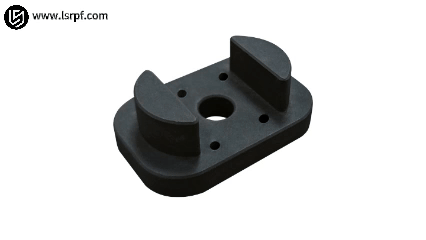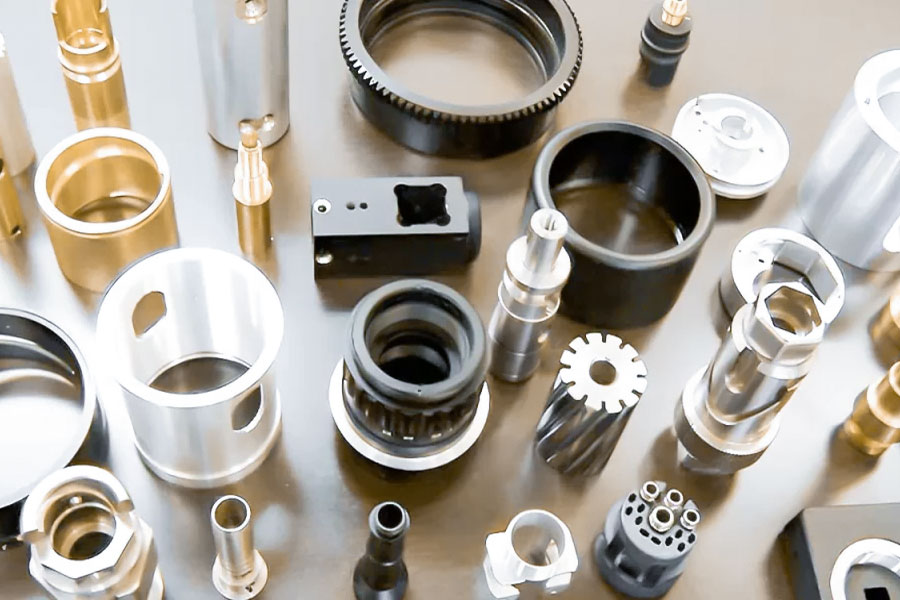In the vast sky of modern manufacturing,5-axis CNC machining technologyis like a bright star, leading the innovation and development of the manufacturing industry with its high-precision, high-efficiency processing capabilities and wide applicability. This technology not only redefines the manufacturing method of complex-shaped parts, but also opens up an unprecedented new chapter in the breadth and depth of material processing. When we talk about 5-axis CNC machining, a core topic that cannot be ignored is the material used.
Today. The Longsheng team will take everyone to have an in-depth discussion of thematerials used in five-axis CNC machining, reveal the characteristics, applications and processing challenges behind these materials, and then show the broad prospects and infinite possibilities of five-axis CNC machining technology in the field of material processing.

What is 5-Axis CNC Machining?
5-Axis CNC machining is a sophisticated manufacturing coursethat features a number of shifting chopping devices alongside 5 axes. This allows the creation of intricate and complicated parts with extreme precision and prime quality.

What does the 5 axis represent?
The term “5-axis” in CNC machining technology represents the five axes in which the cutting tool can move and rotate simultaneously. A typical CNC machine has three linear axes (basic axes) and three rotary axes (A, B, and C), a 5-axis machine will move along the linear axes and two rotary axes.
- X axis:The X-axis represents the horizontal movement of the cutting tool along the length of the machine tool, either left to right or right to left, depending on the machine configuration. Movement along the X-axis enables CNC machining operations such asmilling, drilling and contouring.
- And axis:The Y-axis represents the lateral movement of the cutting tool, which can be from front to back or back to front, depending on the machine configuration. Movement along the Y-axis enables CNC machining operations such as side milling, grooving and profiling.
- Z axis:The Z-axis represents the vertical motion of the cutting tool. Depending on thetype of 5-axis CNC machine, the movement can be up and down. Movement along the Z-axis enablesCNC machining operationssuch as drilling, tapping and boring.
- A axis:The A-axis represents the rotational movement of the cutting tool about the X-axis - tilt or rotation. This axis provides greater flexibility and is compatible with undercuts, chamfers, and angle features.
- B axis:The B-axis represents the rotational motion of the cutting tool about the Y-axis. This axis enables multi-sided machining and machining features such as deep grooves, complex contours and curved surfaces.
- C axis:The C-axis represents the rotational motion of the cutting tool about the Z-axis – it tilts or rotates vertically.

What are the advantages of 5-axis CNC machining?
5-axis CNC machining has revolutionizedthe manufacturing industry, offering a plethora of advantages that enhance production capabilities. Here are some of the key benefits:
| Advantages | Description |
| Complex Shapes | The ability to machine complex shapes and intricate designs that are impossible with traditional 3-axis machines. |
| High Precision and Repeatability | Exceptional precision in machining, ensuring parts are consistently produced with high accuracy. |
| Improved Setup Efficiency | Reduced setup times as multiple sides of a part can be machined in a single setup, enhancing production efficiency. |
| Quality Surface Finish | The ability to achieve superior surface finishes, reducing the need for additional finishing processes. |
| Faster Material Removal | Efficient material removal rates, especially in complex parts, speeding up the production process. |
What are the disadvantages of 5-axis CNC machining?
While5-axis CNC machining offers significant advantages, it also has certain disadvantages:
| Disadvantages | Description |
| High cost | Initial investment and maintenance costs for five-axis machines are typically higher than for traditional CNC machines. |
| Programming Complexity | Creating 5-axis machining programs can be more complex, requiring advanced software and skilled programming. |
| Skilled Operator Required | Operating and troubleshooting a 5-axis machine requires a higher level of skill and training. |
What Materials Are Used in 5 axis CNC Machining?
Five-axis CNC machining has important applicationvalue in many fields due to its high precision, high efficiency and wide applicability. Its commonly used materials are also very wide. The following is an introduction to commonly used metal materials, plastic materials and composite materials. Detailed summary of materials:
1.Metals
Metal materials are one of the most common and widely usedmaterials in 5 axis CNC Machining. They have high strength, good corrosion resistance and thermal conductivity, and can meet various complex and precise processing needs. Common metal materials include:
| Material | Feature |
| Aluminum | Offers excellent machinability, high strength-to-weight ratio, and superior corrosion resistance, making it perfect for lightweight, durable machined parts. |
| Stainless steel | Stainless steel offers superior corrosion resistance, high strength, excellent toughness and ease of fabrication, ideal for demanding machining operations. |
| Copper | Copper displays excellent thermal conductivity, electrical conductivity and plasticity. It is also highly ductile, corrosion resistant and can be easily welded. |
| Titanium | Titanium It’s a metal with excellent strength-to-weight ratio, low thermal expansion, high corrosion resistance; sterilizable and biocompatible for machining. |
| Brass | Brass has desirable properties for a number of applications. It is low friction, has excellent electrical conductivity and has a golden (brass) appearance. |
2.Plastics
Plastic is also a very popular choice for 5 axis CNC Machining due to its wide selection, relatively low prices, and significantly faster machining times required. The following are some common5 axis CNC Machining plastic materials:
- ABS:It has good processing performance and mechanical strength, and is often used in electronic product casings, automobile parts, etc.
- Polycarbonate (PC):It has high strength, high transparency and good heat resistance. It is often used to make optical components, transparent parts, etc.
- Nylon (PA):wear-resistant, oil-resistant, and water-resistant, often used to make gears, bearings, etc. Polypropylene (PP): Due to its low density, corrosion resistance, and ease of processing, polypropylene is widely used in the manufacture of containers such as cups, basins, and buckets, as well as the casings of electronic products.
- Polyvinyl chloride (PVC):PVC has good chemical resistance and electrical insulation properties and is suitable for a variety of industrial fields.
- Polytetrafluoroethylene (PTFE):PTFE is often used to manufacture seals, pipes, etc. due to its excellent high temperature resistance and chemical corrosion resistance.
- Polyethylene (PE):PE is a commonly used plastic material with good flexibility and impact resistance. It is widely used in packaging, agriculture and other fields.
3.Composites
Five-axis CNC machining is also commonly used in the processing of composite materials. These composite materials usually have excellent properties and special uses, such as high-strength lightweight materials, corrosion-resistant materials, etc. Common composite materials include:
- Carbon fiber composite materials:Carbon fiber composite materials have the characteristics of high strength, high modulus and low density, and are widely used in aerospace, automobile manufacturing, sporting goods and other fields.
- Fiberglass:Fiberglass is a composite material composed of resin and glass fiber. It has excellent corrosion resistance, light weight and high strength. It is often used in the manufacture of boats, storage tanks, etc.

What are the applications of 5-axis CNC machining?
5-axis CNC machining plays an important role in modern manufacturing, with wide applications and significant effects. The following is a detailed analysis of the application of 5-axis CNC machining in different fields:
Theadvantage of 5-axis CNC machiningis that it can greatly improve the machining efficiency and machining quality, but also reduce the production cost, so 5-axis CNC machining has a wide range of applications in industry, covering many fields. The following are some of the main industrialapplications of 5-axis CNC machining:
Aerospace field
In the field of aerospace,5-axis CNC machining is widely used in the production of aircraft,missiles and satellites. 5-axis CNC machining can be realized on a variety of materials, including high strength titanium alloy, nickel base alloy and stainless steel. 5-axis CNC machining can produce lighter and more robust space structures, thereby improving the performance and efficiency of airborne equipment.
Shipbuilding industry
5-axis CNC machining in the shipbuilding industry can be used to manufacture ship structural parts, propellers, ship mold and so on. The 5-axis CNC machining can realize the high precision machining of Marine parts and the manufacture of complex surface.
Automobile manufacturing
5-axis CNC machining is used in the automobilemanufacturing industry to manufacture engine parts, chassis parts, body structure, etc. It can realize the machining of complex surface, improve the precision and quality of parts, and reduce the number of spare parts in the assembly process.
Medical field
5-axis CNC machining in the medical industrycan manufacture a variety of high-precision medical instruments, such as artificial joints, implants, dental orthotics, etc. 5-axis CNC machining can improve medical results by precise cutting and machining to produce medical devices that are more suitable for patients’ needs.
Art and sculpture
5-axis CNC machining in the art production and engraving industry can achieve complex three-dimensional engraving and surface details machining , to meet the creative needs of artists and designers.

Start your project with LS CNC machining services
Whether you are developing new product prototypes, making parts or testing new designs,LongshengTechnologyonline CNC machining servicescan meet your needs. Our CNC machining center uses the most advanced equipment and technology in the industry to provide accurate and consistent production for your project.
We provide fullycustom CNC machining servicesto meet the needs of all types and sizes of projects. Whether it is small or large, we can provide you with the best service. We have all the necessary tools and techniques to ensure that your project is processed in a timely and high quality manner.
Our machining equipment and technical team are ready to provide you with the best quality service. Don’t hesitate tocontact us immediatelyto take full advantage of our machining techniques and professional options to start your next project.
FAQs
1.What are 5 different materials that can be used on a CNC machine?
The five different materials that can be used onCNC machine toolsmainly include: ① High-speed steel: a commonly used tool and workpiece material with high hardness and wear resistance, suitable for general cutting processing. ②Cemented Carbide: An alloy material made from hard compounds of refractory metals and bonded metals through a powder metallurgy process. It has high hardness, high wear resistance and high heat resistance. It is one of the main materials for cutting tools. one. ③Ceramic: It has high hardness, high wear resistance and high chemical stability, and is suitable for processing environments with high temperature, high pressure and high hardness, such as ceramic cutting tools and certain workpiece materials.④Diamond: The hardest substance in nature, with extremely high hardness and wear resistance, it is the tool material of choice for processing difficult-to-machine materials (such as cemented carbide, ceramics, etc.). ⑤ Cubic boron nitride (CBN): A synthetic super-hard material, its hardness is second only to diamond, but its thermal stability is higher. It is suitable for processing difficult-to-machine materials such as high-temperature alloys and hardened steel.
2.How does 5 axis CNC machining work?
Theworking principle of five-axis CNC machiningcan be simply summarized as linkage control of five independent axes (three linear axes X, Y, Z and two rotary axes A, B or C) through a computer numerical control (CNC) system to realize the tool All-round, high-precision processing of workpieces in three-dimensional space.
4.What are the applications of 5 axis machining?
Five-axis machining has been widely used in many fieldsdue to its high precision, high efficiency and high flexibility, mainly including: aerospace: used to process complex curved surface parts such as aircraft engine blades and turbine disks. Automobile manufacturing: used to process key components such as automobile engine crankshafts and connecting rods. Mold manufacturing: used to process various complex molds and cavities. Medical equipment: used to process precision medical equipment and instruments. Precision parts manufacturing: used to process various high-precision and high-demand parts, such as optical parts, precision mechanical parts, etc.
Summary
Five-axis CNC machining technology plays an important role in the processing of metal and non-metal materials due to its high precision, high efficiency and high flexibility. Whether it is metal materials such as titanium, aluminum, copper, ABS plastic, nylon, polycarbonate plastic materials, carbon fiber composite materials and other composite materials, five-axis CNC machining can achieve high-precision and high-efficiency processing. With the continuous development of technology, five-axis CNC machining will play an important role in more fields and promote the transformation and upgrading of the manufacturing industry.
Disclaimer
The content on this page is for reference only.Longshengdoes not make any express or implied representation or warranty as to the accuracy, completeness or validity of the information. No performance parameters, geometric tolerances, specific design features, material quality and type or workmanship should be inferred as to what a third party supplier or manufacturer will deliver through the Longsheng Network. It is the responsibility of the buyerseeking a quote for partsto determine the specific requirements for those parts.Pleasecontact usfor moreinformation.
LS Team
This article was written by multiple Longsheng contributors. Longsheng is a leading resource in the manufacturing sector, withCNC machining,sheet metal fabrication,3D printing,injection molding,metal stamping, and more.





